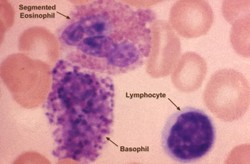Secondary erythrocytosis may result from cigarette smoking, chronic respiratory insufficiency, and congenital cyanotic heart disease. In some types of employment, it is also possible to encounter exposure with carbon monoxide, and this too may affect red cells [1].
Uncommonly, humans may produce too much erythropoietin, a hormone that regulates the amount of red blood cells in the body. Such a situation can be the result of a tumor that generates excessive amount of the hormone [1].
Moreover, some clients who take male sex hormone supplements or abuse erythropoietin itself may experience high levels of red cells in the peripheral blood. The receipt of a kidney transplant is another possible source of the problem as the hormone erythropoietin naturally originates from that organ [1].
People who reside at high altitudes may also carry high red cell counts [1].
Rarely, it can also be a hereditary condition such as benign familial polycythemia, and the inheritance pattern may be either autosomal dominant or autosomal recessive. The type of transmission will, of course, depend on where the genetic mutation takes place [2].
Spurious polycythemia may occur when the plasma volume decreases dramatically, and this will lead to an excessive concentration of red cells relative to the fluid which is present [1]. The word “spurious” alludes to something which is neither genuine nor authentic; hence, this form of disease has its name because the abnormal red cell concentration is the consequence of low plasma volume rather than too many red cells.




 The Reality of Aspirinon 05/24/2021
The Reality of Aspirinon 05/24/2021
 An Old Microbeon 03/31/2021
An Old Microbeon 03/31/2021
 Coronavirus and Mental Illnesson 02/14/2021
Coronavirus and Mental Illnesson 02/14/2021
 Acute Ischemic Strokeon 12/25/2020
Acute Ischemic Strokeon 12/25/2020


Comments